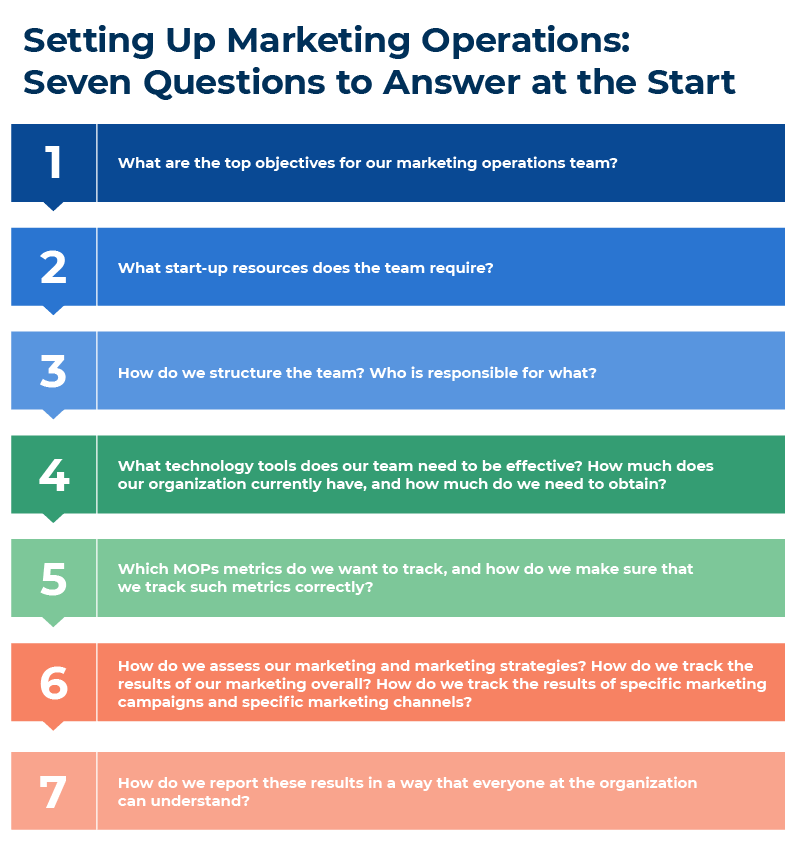What Is Marketing Operations?
Marketing operations (MOPs) refers to the activities required to implement and oversee the technology and processes that foster an effective marketing team. A marketing operations team helps drive positive marketing results for a company.
Jeff Pedowitz, President and CEO of the Pedowitz Group, a marketing consulting company based in Atlanta, says that one of the biggest mistakes companies make is underinvesting (or not investing at all) in marketing operations.
“I think that most companies don’t understand the importance of marketing operations and often end up overlooking it or misappropriating it,” he says.
Pedowitz adds that marketers must hone their brand and creative marketing, while also focusing on the data and analytics that measure results.
“You really can’t have one without the other,” he continues. “It’s really about getting marketing (and business) leaders to understand how important marketing operations is to the team. MOPs gives you the tools and the analysis to demonstrate value to the business.”
Here are some of the primary characteristics of marketing operations:
- It Does the Backstage Work: Your marketing operations specialists won’t write the marketing emails, rebuild your website, or move prospective customers from an inquiry through the sales process. But, they will build and manage the processes that make all of that happen. Without people doing that behind-the-scenes work, marketing is more haphazard and less effective.
- “I think of it [MOPs] as everything that’s happening behind the scenes to make the marketing work,” says Kelly Ann Collins, CEO of Vult Lab, a digital agency that helps brands, nonprofits, and non-governmental organizations with integrated marketing communications. “It’s everything you don’t see. When most people see marketing work, they see the nice, pretty, finished product. But, they don't see all that work that goes on behind the scenes to make that [finished product] happen.”
- It Helps Your Company Qualify Sales Leads: When marketing has attracted a potential customer, marketing operations helps move that prospective customer through the sales funnel and related processes. It helps to deliver the best prospects to your sales team.
- “We're talking about the business processes that enable marketing and salespeople to efficiently move a customer through the process, from introduction to onboarding,” says Jenn Morgan, CEO and Lead Strategist at Radically Distinct, a Seattle-based brand strategy and digital marketing agency. “And, if you don't have that process right, or if you don't have it defined, then it’s very hard to do. Consequently, you don’t do it regularly, and you certainly don’t do it as optimally as you could.”
- It Creates and Manages Systems and Processes: Marketing operations builds and manages the processes that make your marketing effective and ultimately, that drive revenue. These processes include creating marketing content, managing data, and measuring results.
- It Helps Manage Vital Marketing Systems and Tools: MOPs builds infrastructure that helps your company choose the appropriate marketing technology and tools. It then ensures that the company is using those tools effectively.
- It Helps Your Company Understand and Use Data: Effective MOPs also builds a system that allows your company to gather and understand data on your customers, products, and marketing itself. That system then helps your company make strategic, data-informed decisions.
- It Is Always Looking for Improvements: Marketing operations focuses primarily on structures, systems, and tools. So, it is always looking for ways to improve those three elements. MOPs ensures that your staff can provide feedback on how everything is working. And, it makes sure that your company performs the necessary adjustments, based on that feedback.
Who Are the Stakeholders for Marketing Operations?
The stakeholders for marketing operations include certain organizational leaders, namely the CEO, CIO, CMO, and director of marketing. By delivering the results that these leaders expect, MOPs can demonstrate that it’s performing well.
These stakeholders expect the following from marketing operations:
- CEO: The chief executive officer expects marketing operations to play a significant part in increasing the company’s overall revenues. The CEO also expects MOPs to show a return on investment (ROI) for marketing spending. In addition, the CEO counts on marketing operations to show how the company’s marketing supports the organization’s overall strategic goals.
- CIO: The chief information officer expects marketing operations to ensure that the company is using the most appropriate technology — and using it well. The CIO also depends on MOPs to ensure that the company remains technologically current.
- CMO: The chief marketing officer entrusts MOPs with the crucial task of aligning marketing with sales. The CMO also depends on these specialists to build a structure that turns prospective customers into actual customers.
- Director of Marketing: The director of marketing looks to marketing operations to work collaboratively with the marketing department’s creative team. The director of marketing also expects MOPs to track and analyze data from specific marketing campaigns. That tracking allows the company to make changes that leverage the results of marketing investments.
To learn more about managing marketing campaigns, visit “The Definitive Guide to Marketing Campaign Management.” You can also find easy-to-use templates for your marketing campaigns at “Free Marketing Campaign Templates and Guide.”
The Pillars of Marketing Operations
Marketing operations covers a wide range of areas and duties, which experts sometimes categorize in different ways. Still, the work generally falls into three categories, or pillars: process management, marketing technology management, and data analytics and management.
Process Management
When a company markets itself to potential customers, such work involves multiple processes. Marketing operations must ensure that those processes make sense and deliver the best results for the company. Those processes include the following:
- Budgeting and Planning:
- Planning strategically to ensure that your marketing investments align with your company’s goals (To learn more about strategic planning in marketing, visit “The Definitive Guide to Strategic Marketing Planning.”)
- Managing the overall marketing budget
- Developing and implementing appropriate marketing strategies
- Developing and implementing processes that enable smart budgeting and planning (To download easy-to-use market budget templates, visit “12 Free Marketing Budget Templates.”)
- Content Creation and Management:
- Helping to manage and track the creation of marketing content
- Helping to manage all marketing content following its creation (To learn more about marketing asset management, visit “Marketing Asset Management: Turn Marketing Assets into Powerful Business Tools.”)
To learn more about marketing workflow when creating content, visit “The Complete Guide to Marketing Workflows: Templates, Tools, and Tips.” and “The 61 Best Free Content Marketing Templates to Drive Performance.”
To learn more about the project management of marketing content, visit “Content Marketing Project Management Toolkit: Workflows, Templates, and Checklists.”
And, to download easy-to-use marketing timeline and marketing calendar templates, visit “Free Marketing Calendar Templates in Google, Excel, and Word Formats” and “Marketing Timeline Tips and Free Templates.”
- Demand Generation/Lead Management:
- Working to increase public demand for your company’s products
- Helping to manage leads (i.e., moving people who express interest in your product or service through the sales cycle to become actual customers)
- Brand Compliance:
- Helping to manage and maintain your company’s overall brand
- Helping to ensure that your company’s marketing adheres to all government regulations
Morgan from Radically Distinct defines brand compliance as, “Helping to determine how to create a perception in the marketplace and then managing that perception in order to continually attract the types of customers you want.”
| Activities That Require Regulation in All Industries | Areas of Marketing That a Government Body Regulates | Government Body That Institutes Such Regulation |
|---|---|---|
| Information Security / Data Management | How an organization stores and uses data about an individual | General Data Protection Regulation (GDPR) - a government body of the European Union |
| Product Advertising | The factual accuracy of product and service advertising | Federal Trade Commission |
| Email Practices | The delivery of unwanted marketing email (SPAM) | Federal Communications Commission |
| Specific Industries | ||
| Health | The privacy of patient information The potential risks to the consumer of such health products | Health Insurance Portability and Accountability Act of 1996 Affordable Care Act Truth in Healthcare Marketing Act of 2017 |
| Finance | Claims about financial products Consumer disclosures about products or services | Securities and Exchange Commission |
| Legal | Marketing about legal services | State Bar Associations Federal Trade Commission |
| Alcohol and Tobacco | All the marketing and advertising of these products | Food and Drug Administration Federal Tobacco Tax and Trade Bureau |
| Publicly Traded Companies | The accuracy of the financial details that a public company uses to market itself | Securities and Exchange Commission The Sarbanes-Oxley Act |
Marketing Technology Management
There are now thousands of technology solutions that help marketing teams do their jobs. These tech solutions help you create content, promote that content, organize social media, and manage projects, among many other tasks.
To download easy-to-use templates for marketing projects, visit “Free Marketing Project Plan Templates.” To learn about the technology that can help you manage marketing projects and processes, visit “How to Pick Marketing Project Management Tools and Software” and “Is Marketing Resource Management (MRM) Dead?”
One of the core responsibilities of marketing operations is managing all of a company’s marketing technology. This means helping the company determine which technology solution best fits its needs and budget, as well as staying abreast of evolutions in technology in order to help the company make necessary upgrades. And, accordingly, it means helping employees understand the new technology and fully leverage its capabilities.
Pedowitz notes that “Owners or managers may think that with more technology, they need fewer people — when the opposite is true. If you truly want to get the most out of the technology, you need people who have the skills to run it and leverage it. Otherwise, you’re sitting on a bunch of expensive technology, and you’re not really changing how you’re doing marketing.”
Source: Simon Daniels, Percassity Associates
Data Analytics and Management
The third key pillar of responsibility in marketing operations is data analytics and management. Some experts consider this particular area to be the most important, as marketing operations must gather, track, and analyze a wide range of data.
Such data concerns the following: a company’s products or services; how the company markets those products or services; and how customers and potential customers react to those products or services (as a result of such marketing efforts).
Marketing operations must do the following:
- Gather and monitor the data and organize it into usable formats.
- Monitor key performance indicators (KPIs), including the ROI for marketing in general and for specific marketing campaigns.
Download Matrix Showing Top KPIs for Marketing and Marketing Operations - PDF
- Create a structure to report the data’s findings to staff and company leaders.
- Analyze the data to determine what it reveals about customers, the company, and the company’s marketing efforts.
- Track conversions, or how (and how often) prospective customers become actual customers.
Collins of Vult Lab says that data analytics is essential to doing “predictive modeling, analysis reporting for clients, and internal reviewing, to make sure your campaigns are actually moving the way they need to be moving.”
“Analytics, or reporting, or measurement — however you want to term it — is about understanding the outcome of the marketing that you're undertaking and, ultimately, knowing what that effort’s return on investment is,” says Simon Daniels, a London-based marketing operations consultant and Principal with Percassity Associates.
To learn more about technology and systems that can assist with all of this marketing information, visit “The Definitive Guide to Marketing Information Management & Systems.”
The Fourth Pillar: Training
Some experts believe that marketing operations includes a fourth pillar that’s separate from the three listed above: employee training.
Marketing operations often helps to continually enhance the skills of the entire marketing team. MOPs achieves this goal by providing ongoing training in the use of new technology and by helping to improve staff skills as the marketing industry evolves. (To learn more about certifications that can enhance a professional marketer’s expertise, visit “Can Marketing Certifications Maximize Your Career?”)
How to Create a Marketing Operations Strategy
As your company launches a marketing campaign or works to improve a marketing process, you need to lay out a marketing operations strategy. That strategy should identify both your goals and your tactics for reaching those goals.
Here are some critical steps for creating a marketing strategy:
- Align Your Strategy with Company Goals, and Identify Stakeholder Needs: Before you execute any strategy, make sure that it aligns with your company’s overall strategic goals. In order to do this, you may also need to figure out how your strategy satisfies some primary stakeholder needs. Those stakeholders could be your customer base or a specific department within your company.
- Write Down Specific Steps to Reach Goals: Enumerate the steps to reach your goals. The very act of writing down such steps forces your team to evaluate whether or not each undertaking is actionable — meaning realistically doable. As you decide on the steps, include who is responsible for each step or task and the timelines and tools they might need.
- Determine How You Want to Measure Success, and Watch Those Measurements: Once you’ve set your goal, you need to establish specific and measurable metrics — namely, data points that clearly indicate the level of success or failure. And, you need to monitor those measurements throughout your process to evaluate your effectiveness.
Here are some examples of possible metrics in various areas of marketing operations:- How Your Teams Are Working:
- Numerical values that reflect the size of a team’s workload
- The length of time it takes to create and complete a task
- The actual amount of time it takes to perform a task (and the actual cost you incur by performing that task) compared to the task’s planned schedule budget
- Your Company’s Budget Effectiveness:
- Numerical values that reflect the accuracy of budgets
- The length of time it takes to complete a budget process
- Other Processes:
- The rate of process completion
- The measurable level of effectiveness in tracking the status of page proofs
- The percentage of deadlines a team meets
- Review and Compliance:
- The measurable level of thoroughness of a team’s review of government regulation content
- Reporting:
- The measurable ROI for each marketing campaign
- The marketing cost per sales lead obtained
- The percentage of sales leads that ultimately turn into customers
Marketing dashboards can help you monitor metrics. To learn more about effective marketing dashboards, visit “Which Types of Marketing Dashboards Are Best for Your Company?”
- How Your Teams Are Working:
- Consult with Employees about the Strategy and Any Refinements: Your team may want to consult with other marketing employees who are impacted by the strategy. Those other employees may have suggestions on how to refine the strategy in order to make it more effective.
In our "Expert Tips on Building an Outstanding Marketing Operations Team" article, you’ll get the most useful expert advice on how to build a marketing operations team, including details on important roles and required skills.
Best Practices for Marketing Operations
Experts recommend a number of best practices to help your company optimize its marketing operations. These best practices include aligning operations with overall business strategy, establishing strong processes, and working continuously to understand your customers.
Here are some recommended best practices:
- Make Sure Marketing Operations Is Strategic, Not Just an Overseer: “It's important for marketing operations to be more than merely a backroom function that just waits to be told what to do,” says Daniels of Percassity Associates. “It is a strategic function. It should be feeding into your strategy from the point of view of customer and prospect identification, acquisition, and management. That sort of go-to-market execution. It’s not just cranking the handle and waiting to be told how high to jump.”
Download Top Five Steps to Start Marketing Ops from Scratch - PDF
- Be Part of the Product Development and Sales Process from the Start: Marketing operations should help the marketing team become an integral part of the product development and sales process from the very beginning. Your MOPs team can provide input on potential market reaction and can think proactively about how to market a product. (To learn more about product marketing and find easy-to-use templates, visit “Product Marketing 101: Templates, Strategies, and Examples.”)
- Think about Your Return on Investment from Marketing Initiatives: Marketing operations should help company leaders think about the potential ROI for overall marketing as well as for individual marketing campaigns. The team should also track these ROIs on its own.
“Okay, so, back-of-the-napkin economics: ‘How much is this customer worth to us?’” asks Morgan from Radically Distinct. “If you gave me one dollar, business owner, and I gave you back four dollars… would you be happy with that? Now, most people would say, ’Yes.’ But, when it comes to investing in marketing, they don't do that at all. It's like, ‘We're going to invest a penny, and we're going to expect a million dollars.’ So, you really have to start by being able to answer these two questions: ‘What is our financial goal? And, how does that relate to our marketing budget?’” - Prioritize: “It [marketing operations] needs to be proactive. There needs to be a prioritization mechanism,” says Daniels of Percassity Associates. “So, you can say: ‘There are a thousand things to do here. Which ones do you want to do first? Because we can’t do all of them.’ And then manage that.”
- Break Down Silos: Marketing operations must break down departmental silos in the company. That means it must lead in getting marketing, information technology, finance, and other departments to communicate and collaborate with each other.
- Understand that Data and Data Analytics Are Key: If marketing operations does nothing else, it must lead the company in gathering and monitoring data about its customers, and also about company marketing. Then, it must analyze that data to understand how to make the necessary changes.
- But, Don’t Enter Data Analysis Paralysis: “You can overdo it,” says Pedowitz of the Pedowitz Group. “You can get so bogged down in standards and process and approvals and governance, that you stop creating emotion. It’s a balance.”
- Understand Who Your Customer Is and Who You’re Trying to Attract: Marketing operations must help the company gain an understanding of the type(s) of customers it is trying to attract.
“You want to understand who your potential customer is, or who you should be going for as your potential customer,” says Morgan. “You want to have a description of who your customer is, and then be able to justify all of the things that you're trying to set up and do, based on how they move through your sales process.”
Morgan suggests that companies create “customer avatars” for their ideal customers, or a detailed profile of a hypothetical customer, that includes demographics, likes, and dislikes. - Understand the Zero Moment of Truth: Marketing operations must help its company understand the “Zero Moment of Truth” for its potential customers, which refers to the moment when a customer first thinks about and begins to do research on a product. (Jim Lecinski coined the term in his 2011 e-book ZMOT, in which he described how the concept functions at Google.).
From there, MOPs must help the company understand the customers’ “First Moment of Truth” and their “Second Moment of Truth.” The First Moment of Truth occurs when the customer decides to buy the product, and the Second Moment of Truth defines the customer experience with the product after buying it.
“This basically means that there's this deliberation period now, when the whole buying process for a customer has changed,” says Morgan. “Your customers are going out and they're checking out your website, they're looking at all these potential competitors, and they're comparing you against these other companies.
“Younger millennials, they’re not even talking to you if your website looks like it's old. Your marketing operations department needs to understand that particular point in time, because it's a relatively new point in time for our customers. It’s the ‘zero moment’ — the moment right before you as a potential customer decide you're going to be a customer of a company,” Morgan emphasizes. - Help Your Company Track Customers through the Full Sales Cycle: Experts say that too often, marketing and marketing operations only track a customer to the point at which they are delivered as a lead to the sales team.
“I would say the number one mistake that I have seen everybody make in their marketing process is that it's not a complete sales cycle,” Morgan says. “They have this arbitrary idea that marketing is this thing you do over here, and sales is this thing you do over here. And they don’t work together in any way.”
This means that potential customers who might need answers to questions about a product aren’t appropriately given those answers, she says. Then, they leave, without ever becoming customers.
- Hire People with Skills, Develop Those Skills, and Make Sure Your Team Continually Evolves: You’ll need to hire people with technology, project management, analytical, and leadership skills, and ensure that everyone on your team is continually evolving and improving those skills as technology and practices change.
- Understand When to Outsource: In some cases, it may make more sense to hire a contractor with the specific skill you need than to hire a full-time employee with that skill, or relying on the halfway knowledge of one of your current team members.
“Outsourcing is an important skill for marketing operations,” says Morgan. She says that, especially as a company starts a marketing operations initiative, it may need specialists to implement some structures.
“If you're trying to create marketing operations, you should not be looking to do every piece of it yourself,” she says. “Figure out what is a good internal hire, along with working with a few different external resources.” - Create and Monitor Operational Metrics: Just as you want to track overall data on your customers and their relationship to your company, you’ll also want to track metrics that measure your own marketing operations. Track metrics surrounding specific marketing campaigns, along with those that track general marketing operations tasks.
“It needs to be broken down into activities that are daily, weekly, monthly … in order to achieve a set goal,” says Morgan. “And then, once you have that process down, you can ask, ‘Did we achieve these goals?’ And if so, ‘Did we actually do all those activities?’ If we did, ‘Did it generate the results? How short of those goals were we?’
“So, it’s important to set goals and write them down, as opposed to just sort of trusting your gut. And then, make activities that meet those goals, and then measure as you're doing the activities, as well as afterward.”
The Benefits of Good Marketing Operations
Strong marketing operations provides a number of benefits to your marketing team and to your overall company. It helps ensure that your marketing is strategic and that it aligns with company goals. It also helps you understand customers and their needs.
Here are some of the main benefits of good marketing operations:
- Provides Oversight for Long-Term Goals: A key role of marketing operations is to help the company focus on long-term goals and then provide the structure to keep everyone on course toward those goals. This will mean setting and tracking overall marketing strategies, as well as tracking the ROI for various marketing initiatives. It will also mean tracking KPIs in a number of areas.
- Creates Alignment and Order: Strong MOPs helps create alignment and order within marketing as well as the larger company, as MOPs teams will create work systems that help everyone within the company.
- Ensures Team and Project Collaboration: Marketing operations also organizes teams within the marketing department and ensures that they are always collaborating.
- Aligns Marketing Roles: Marketing operations also helps to align all roles within the marketing team, and to ensure that all important tasks and processes are assigned to a specific person or team.
The benefit of this is especially noticeable in companies that don’t have staff devoted to marketing operations, says Daniels, of Percassity Associates.
“If you don’t have a function focused on it [MOPs] — be that an individual or team — then it means that those functions are spread out across all the individuals on your marketing team,” Daniels says. “The disadvantage of that is that it becomes nobody's job, which means it's probably the last thing that everybody is really thinking about.” - Ensures Data Transparency: Good marketing operations ensures that relevant data is gathered and tracked. The entire company will most often have access to that data. This helps everyone make decisions and suggest changes based on the data.
- Encourages Process Consistency: Marketing operations creates a structure in which processes are consistent and repeatable. This saves staff time and energy, and saves the company money.
- Ensures Readiness for Future Growth: When marketing operations allows for transparent and consistent processes, the company can better understand how to expand those processes with future growth.
- Solves the Needs of Customers, Stakeholders, and Employees: Good marketing operations will recognize and solve the needs of a company’s customers, stakeholders, and employees.
- Helps Companies Make Adjustments Where Needed: Marketing operations will track more than just marketing work, including how fast certain products are selling, what isn’t selling, and any warehousing and delivery issues. Tracking all of this will help both the company and the marketing department make the necessary changes.
- Responds to Market Trends: Marketing operations helps the company track customers’ needs, responses, the performance of the competition, and overall market changes. From there, it can help the company make needed adjustments.
- Helps Identify New Markets: The strategic planning and data analysis that marketing operations coordinates will help the company spot opportunities for new markets and expanded sales.
- Helps Optimize Marketing Channels: Marketing operations helps a marketing team understand results from all marketing channels, including email marketing, social media, advertising, print media, and more. Having such an enlarged perspective enables the company to better determine which channels work best for specific marketing goals.
To learn more about automated email marketing, visit “Automated Email Workflows: Examples, Best Practices, and Templates.” And, to learn more about marketing in a number of channels at the same time, visit “The Definitive Guide to Real Omnichannel Marketing and Tips for Implementing Your Own Strategy.” - Helps Companies Become More Transparent, Efficient, and Profitable: Good marketing operations encourages strategic planning and the constant monitoring of important marketing and other operations. Such efforts make a company more transparent, accountable, efficient, and profitable.
The Future of Marketing Operations
Marketing operations experts predict significantly increased automation and that sales and marketing teams will merge within some companies.
Detailed expectations for the future of marketing operations are as follows:
- Sales and Marketing Partnerships: Marketing operations in forward-thinking companies will have sales and marketing departments that work much more closely and collaboratively. They will share information on customers and work together to determine how to attract and convert customers.
Daniels believes some companies may even merge their sales and marketing departments. “From a bigger picture perspective, the hot topic is the putative merging of marketing operations and sales operations, and potentially customer success operations, into a revenue operations function,” he says. - Increased Automation: As the number of marketing technology tools continues to expand, many experts believe that there will soon be even more tools available that allow smaller companies to automate many of their marketing operations activities.
“The future will be really cheap automated services for people who know what they’re trying to accomplish,” says Morgan. “But, you are still going to need the brainpower to figure out how to use those tools.” To learn more about current marketing automation software, visit “How to Choose a Marketing Automation Platform.” - Merging of Marketing Technology Tools: There are now thousands of marketing technology tools, and many companies use several or more at the same time. Pedowitz says that new market technology solutions combine data and analysis that exist on several platforms into one platform. The all-in-one platform is easier to use and performs better analysis.
The History of Marketing Operations
Marketing operations existed long before it became known as such. Here are some notable times and dates during the development of the discipline:
- In the 1920s, radio advertisers were doing research to better understand their customers, how such customers reacted to their advertising, and how they reacted to the overall marketplace.
- The president of Scott Paper Company, along with others, founded the Marketing Science Institute in 1961. It has supported research into marketing and what is now considered marketing operations.
- In 2005, marketing consultant and professor Gary Katz published the first article on marketing operations on the MarketingProfs website.
- By 2011, marketing operations had become the fastest-growing occupation in marketing and the fourth-most staffed marketing function in large corporations.
How Does Marketing Operations Help Agencies?
Marketing operations within a marketing agency helps increase efficiencies and better coordinate the work of everyone within the agency. It improves communication, saves money, and increases customer satisfaction.
When Should a Company Hire for Marketing Operations?
According to many experts, a company should create a marketing operations role when technological demands and efforts at collaboration are noticeably slowing down the marketing team.
Some MOPs gurus go further: They say that marketing operations is so vital to a company that the second hire of any marketing team should be for an oversight role. Therefore, a two-person marketing department should consist of one marketing position and one marketing operations position. In fact, even in a one-person marketing department, the individual employee should be performing marketing as well as MOPs tasks.
Implement and Master Marketing Operations with Smartsheet
The best marketing teams know the importance of effective campaign management, consistent creative operations, and powerful event logistics -- and Smartsheet helps you deliver on all three so you can be more effective and achieve more.
The Smartsheet platform makes it easy to plan, capture, manage, and report on work from anywhere, helping your team be more effective and get more done. Report on key metrics and get real-time visibility into work as it happens with roll-up reports, dashboards, and automated workflows built to keep your team connected and informed.
When teams have clarity into the work getting done, there’s no telling how much more they can accomplish in the same amount of time. Try Smartsheet for free, today.






